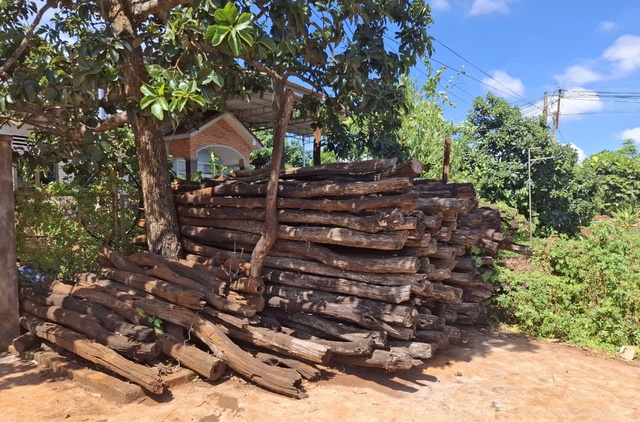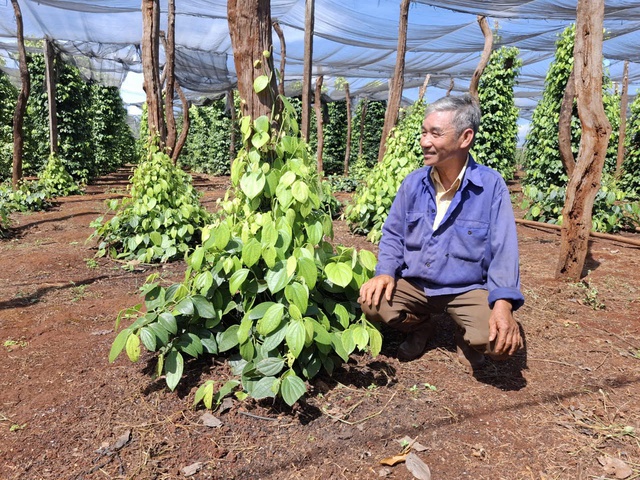Reviving the pepper 'kingdom' in Gia Lai
After a period of hardship due to the tragic drop in pepper prices, mass pepper deaths, and the consequence of Gia Lai farmers bearing a thousand billion bank debt, many people have now returned to pepper cultivation.
A time of "black gold"
Pepper plants in Gia Lai have helped farmers' lives improve, leading to many prosperous residential areas. In particular, the two districts of Chu Se and Chu Puh are known as the "Kingdom of Pepper" because of their suitable climate and soil, so pepper grown here has the highest yield in the country, about 3 - 6 tons/ha.
In the years 2010 - 2012 and the peak of 2014 - 2015, pepper prices peaked at 200,000 - 250,000 VND/kg and were considered "black gold". The Chu Se pepper brand was born, becoming a major brand of Gia Lai when it was present in over 80 countries and territories.
Mr. Hoang Phuoc Binh, Permanent Vice President of Chu Se Pepper Association, recalled: “After the pepper harvest, farmers have billions of dong, can afford to build houses, buy expensive furniture. Pepper billionaires driving cars to visit the gardens is a daily occurrence here.”
That is why people rushed to grow pepper. The whirlwind of pepper development in Gia Lai increased rapidly, beyond the recommendations of the authorities on the process of selecting varieties, planting, and caring. According to the plan, by 2015, the pepper area of Gia Lai was 6,000 hectares and would remain the same until 2020, but statistics by mid-2017 showed that the pepper area in Gia Lai had reached 18,000 hectares, behind Dak Nong with 30,000 hectares and Dak Lak with 25,000 hectares.
The immediate billion-dollar profit has caused many farmers to rush to buy land and switch to growing pepper. Not only that, pepper varieties are bought in a floating market, techniques vary from person to person, and chemical fertilizers and pesticides are poured into the garden with the ambition of making pepper grow quickly and achieve the highest yield.
But the consequences of rapid growth came quickly. Pepper was infected with an incurable disease. There were hectares of pepper gardens that were left with only bare stalks after only half a month of disease. Along with the drought and heavy rains during the period of 2015 - 2019, many large pepper growing areas in Gia Lai were in dire straits. From about 18,000 hectares, Gia Lai's pepper area was reduced by more than half. By 2020, pepper prices had dropped to a record low, only 36,000 - 40,000 VND/kg.
There was a time when pepper poles were sold by people at cheap prices.
PHOTO: TRAN HIEU
Households mortgaged their land and houses to borrow money from banks, hoping to change their lives from “black gold” and eventually suffered the consequences. Each wooden pole used to grow pepper, which at its peak cost 80,000 – 140,000 VND, was uprooted by farmers and sold for a cheap price of 15,000 – 20,000 VND. Sadness spread quickly in the “Pepper Kingdom” like a nightmare. The once luxurious villas became deserted because many owners had to leave their homeland to work far away, working hard to earn money to pay off bank loans.
Mr. Hoang Phuoc Binh sighed: "No development can go on forever, it must have a period of stagnation and problems arising like a sine wave graph. Pepper is the same!"
Pepper reconstruction
Since the beginning of 2024, pepper prices have increased again. If at the end of May, pepper prices fluctuated between 115 and 117 million VND/ton, by October 22, domestic pepper prices increased by 500,000 to 1 million VND/ton in key growing areas, ranging from 144 to 145 million VND/ton. According to experts, this sudden increase only occurred in one day because export enterprises lacked export goods in signed contracts, so there was a phenomenon of massive hoarding.
The International Pepper Community (IPC) reported that the export price of Vietnamese black pepper is listed at 6,500 - 6,800 USD/ton, while white pepper fluctuates around 9,500 USD/ton. Pepper exports are positive, bringing pepper back to Vietnam's billion-dollar commodity. The Vietnam Pepper and Spice Association (VPSA) said that from the beginning of the year to October 15, Vietnam exported nearly 210 tons of pepper, worth 1.05 billion USD (down 1.9% in volume but up 47% in value compared to the same period in 2023).
With prices rising again, many farmers in Gia Lai have begun to explore and replant pepper trees. However, the old pain still haunts them, so they are currently only planting sparingly or replanting on old pepper trees interspersed in coffee gardens.
Rebuilding pepper after the disaster
Photo: TRAN HIEU
Mr. Hoang Phuoc Binh said: “The increase in pepper prices is an opportunity to revive this high-value crop in the coming time. We regularly propagate and encourage people to be careful in choosing varieties when planting new crops and thoroughly apply scientific intensive farming measures to avoid risks. We also connect with purchasing enterprises and fertilizer suppliers to cooperate with people to build demonstration models of organic and clean pepper production for people to learn and apply to improve economic efficiency. This is a long-term direction, suitable for export market demand.”
The plan of Gia Lai Provincial People's Committee is to develop and maintain a stable pepper area of about 10,000 hectares by 2030, promote the development of pepper production in an organic direction, applying high technology...
Mr. Tran Minh Trieu, Vice Chairman of the People's Committee of Chu Se District, said that the pepper growing area recorded at the end of July 2024 in the whole district was 1,132 hectares, a slight increase compared to a few years ago. The fact that people are returning to develop pepper growing areas in the district is a good sign, because this is one of the crops with high economic value, suitable for the local climate and soil conditions.
“We recommend that people should not plant new trees en masse, and should consult experts to ensure that the garden grows safely, stably, and avoids disease,” said Mr. Trieu.







No comments:
Post a Comment